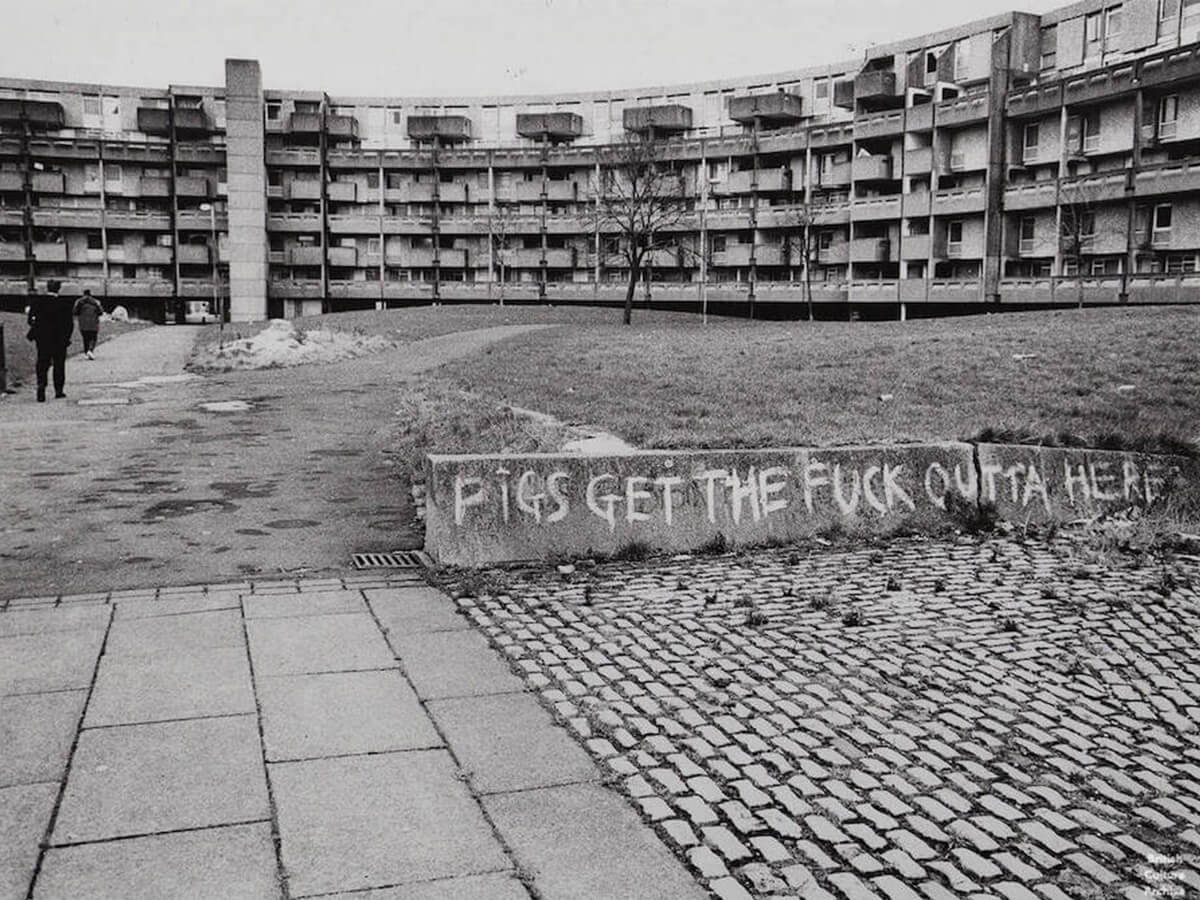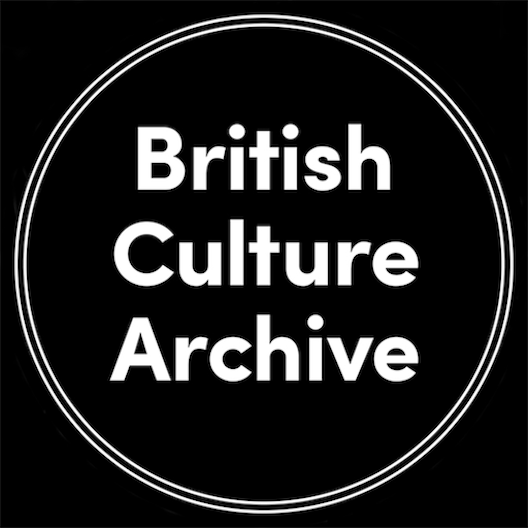

Hulme in the 1980s and early 1990s – a time when this inner city suburb of Manchester was a haven for squatters, punks, drop-outs and artists. With its brutalist concrete crescents and graffiti-ed-up walkways – there was nowhere quite like it.
Photographer Richard Davis, a former resident of Hulme, lived in Charles Barry Crescent – one of the four brutalist crescents that dominated the area. Built after the slum clearances of the sixties, this version of Hulme has a lot of history, good and bad. A place that needs to be documented and preserved for future generations. Along with David Chadwick, Adam T. Burton, and Al Baker, Richard’s images are an important social record of this inner-city suburb of Manchester.
Richard Davis
Richard: “I grew up in Birmingham and left school in 1982 with no real qualifications or idea what to do. I spent a few years on various worthless schemes, but mostly, I was signing on. It was while I was receiving unemployment benefits that my interest in photography grew. I got involved with Birmingham Trades Council’s ‘Centre For The Unemployed’. I was encouraged to photograph things that caught my eye in the street and the many political demonstrations happening at that time in the Midlands.”

Photo © Richard Davis, all rights reserved.
Darkroom
“They had a darkroom at the centre, which I took to, and it was only a short time before I was teaching basic photography and darkroom skills to other unemployed people. I loved it, and a lifelong love of photography began. Someone at the centre suggested I look into getting a qualification in photography. Before I knew it, I had been accepted onto a course at Manchester Poly, which started in September 1988.”

Photo © Richard Davis, all rights reserved.
Lawless
“I had always loved Manchester music, so I didn’t need any persuasion to leave Birmingham for a new life up North. On day one at the Poly, we were advised to avoid going into Hulme, a neighbouring district to where the Poly was situated. We were told Hulme was dangerous, lawless, and should be avoided. However, the next day, I decided to explore Hulme and see for myself. I never did like being told what I should or shouldn’t do!”

Photo © Richard Davis, all rights reserved.
Photogenic
“Little did I know at the time, Hulme would play a massive role and shape my life for many years. I took to it straight away. How could you not? It was just so damn photogenic and very different from anywhere I had seen before. Much of it was derelict, while what was occupied consisted of a diverse mix of artists, musicians, ex-students, and the unemployed – the kind of people mainstream society seemed to reject.”

Photo © Richard Davis, all rights reserved.
“Hulme had the most amazing creative spirit and sense of community; for many people, it was a real source of inspiration and energy. I quickly made friends with various musicians, and the word got out that I had a camera and knew how to use it. It was that easy. This was way before mobile phones and, at that time, Manchester didn’t have many photographers.” – Richard Davis.
Photo © Richard Davis, all rights reserved.
Hulme Crescents
“After only a few months in Manchester, I was offered the keys to squat in Charles Barry Crescent, one of the four big Hulme Crescents. The flat used to belong to Harry Stafford from the Manchester band “Inca Babies”. It turned out I could have his place as long as I forwarded the mail that his band used to receive. I was in heaven, with my own rent-free place, which I eventually converted into a darkroom and studio.”
Walkways In The Sky
“The flat had no windows at the front—all boarded up—which was perfect, as no light would get in. The only problem was keeping the temperature consistent for developing and printing photos. This proved difficult in winter as it was so cold. The flat only had one plug-in heater. Hulme was ideal to use as a backdrop for my photos; all concrete and strange walkways in the sky and an amazing lack of colour which suited what I was after.”
Photo © Richard Davis, all rights reserved.
Madchester
During the late 1980s and early 1990s, Manchester became “Manchester”, and the city went through a huge creative period. Living there, you could certainly feel the energy and excitement. It’s funny because I moved to Manchester mainly because of the music scene. I’m a massive fan of Joy Division, Buzzcocks, The Fall, Magazine, etc. However, during those years, I found myself at the centre of the burgeoning comedy and spoken-word scene.
Steve Coogan
“I became good friends with Henry Normal (who later formed Baby Cow Productions with Steve Coogan). I met and became friends with Caroline Aherne, John Thomson, Steve Coogan, Lemn Sissay, and Dave Gorman through Henry. I photographed Steve a lot and helped with projections at his early comedy shows.”

Photo © Richard Davis, all rights reserved.
Steve Redhead
“After completing my two-year course at the Poly, I spent a further year hanging around with Steve Redhead (known as Professor Rave), who ran the Unit for Law and Popular Culture. Steve was working on a project that involved the crossover of football, music, and fashion. He wanted me to take photographs for a book on this topic. It was a productive time for me. Many photos taken around this period were shown in various exhibitions, and the book, ‘Football With Attitude,’ was published in 1991.”
“I always felt lucky living in Hulme, having my darkroom and studio right in the heart of everything. All the clubs and gigs were within walking distance of my flat, and most of the time, I took my camera along to capture it all.”
Gallery
Photo © Richard Davis, all rights reserved.
Photo © Richard Davis, all rights reserved.
Photo © Richard Davis, all rights reserved.
Photo © Richard Davis, all rights reserved.
Photo © Richard Davis, all rights reserved.
Photo © Richard Davis, all rights reserved.
Richard Davis’s work was exhibited as part of BCA’s debut exhibition at The Social in 2019. Select works were also included as part of the British Culture Archive exhibition at the annual British Shorts Festival in Berlin.
A selection of his Hulme series are part of the touring exhibition – The People’s City.
Richard Davis | Prints
Related Content
- Article first published
READ NEXT
SUPPORT BCA
British Culture Archive is an independent archive and cultural resource set up through a genuine passion for photography. Since 2017, we have supported British photography by publishing and exhibiting works from photographers and by unearthing and giving a global platform to previously unseen photography.
Our online galleries and exhibitions will always be free for everyone. Public support and funding are vital for us to continue documenting and preserving important photography. If you appreciate our work, please consider donating through the link below.











